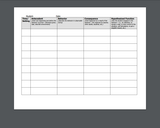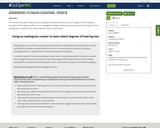
ABA Educational Resources
- Subject:
- Exceptional Children
- Material Type:
- Teaching/Learning Strategy
- Author:
- ABA Educational Resources
- Date Added:
- 01/23/2020

ABA Educational Resources

This is a document to obtain data. List the antecedent to the behavior that is presented. Then the behavior that occurred. Lastly, write the consequence that was given for the behavior. Outline the time and setting that the behavior took place. Then document a hypothesized explanation of why the behavior was displayed.

ADDING TEXT REMIX of Remix: Election Day: Our Civic Duty & Why It Matters: Grade 3-5
Students will build background and show understanding about government elections at the local, state, and national levels in the United States.
Students will write, revise, and edit an informational piece to demonstrate mastery of the topic of elections incorporating key academic content vocabulary.
Students will create a PPT with a teacher's model to demonstrate understanding and mastery of key content area vocabulary words.
Students will complete activities during independent work time or literacy stations. Provides a QR code for students to listen to stories (2 non-fiction and 1 fiction) about elections. After they listen to the stories they choose one of the non-fiction texts to write facts about, find the main idea and key details, and define new words

Autism Focused Intervention Resources & Modules (AFIRM) is an extension of the National Professional Development Center (NPDC) on ASD.
Self-paced modules on evidence based practices as well as an overview of autism. Requires user to create a free account to access.

This resource provides students with a audiogram simulator students can use to guage levels of auditory perception of the right and left ear on an audiogram leading students to determine levels of hearing loss from hearing with in normal limits, mild, moderate, severe, to profound.

This dashboard is a collection of tools to support a variety of accessibility needs including Autism, Dyslexia, hearing, visual, and more.

When giving a modified assignment or test, teachers need to keep evidence of doing so. This accommodation key can be utilized to assist with documentation of providing accommodations. The resource could be used to print labels. The labels can then be attached to the student work that was modified.

When giving a modified assignment or test, teachers need to keep evidence of doing so. This accommodation key can be utilized to assist with documentation of providing accommodations. The resource could be used to print labels. The labels can then be attached to the student work that was modified.

When giving a modified assignment or test, teachers need to keep evidence of doing so. This accommodation key can be utilized to assist with documentation of providing accommodations. The resource could be used to print labels/staple to the student work. The labels can then be attached to the student work that was modified.

When giving a modified assignment or test, teachers need to keep evidence of doing so. This accommodation key can be utilized to assist with documentation of providing accommodations. This resource can be used to provide to general education teachers as well as a resource for case manager cheat sheet.

When giving a modified assignment or test, teachers need to keep evidence of doing so. This accommodation key can be utilized to assist with documentation of providing accommodations. The resource could be used to print labels. The labels can then be attached to the student work that was modified.

When giving a modified assignment or test, teachers need to keep evidence of doing so. This accommodation key can be utilized to assist with documentation of providing accommodations. This resource can be used to provide to general education teachers as well as a resource for case manager cheat sheet.

When giving a modified assignment or test, teachers need to keep evidence of doing so. This accommodation key can be utilized to assist with documentation of providing accommodations. The resource could be used to print labels. The labels can then be attached to the student work that was modified.

When giving a modified assignment or test, teachers need to keep evidence of doing so. This accommodation key can be utilized to assist with documentation of providing accommodations. The resource could be used to print labels. The labels can then be attached to the student work that was modified.

This packet of 41 short selections can be used regularly over the course of a school year to help students build fluency. There are enough passages to work on one per week - to two weeks. This source provides a protocol outlining strategies to engage students in short, daily fluency practice. Teachers can also send passages home for additional practice. To access the packet, select "View File" to download.
This packet is designed to strengthen the components of reading fluency: accuracy, rate, and prosody (expression). Students should understand what they are reading, thus embedded supports, such as student glossaries and ‘right there’ comprehension questions, are included. However, these passages are not intended for close reading or deep comprehension work.
Note for teachers of English Language Learners (ELLs): Regular fluency practice is essential for helping ELLs improve their overall literacy skills. Those acquiring a second language benefit especially from additional support with decoding, pronunciation, word identification, and prosody—all of which are the focus of regular fluency practice. Activities found in the Achieve the Core Fluency Packet reflect several best practices for English Language Learner instruction including:
• Having a text read aloud by a fluent reader prior to the student engaging with the text.
• Giving students multiple opportunities to hear the text read aloud by a fluent reader so that they can mirror the pronunciation and prosody of well-spoken English.
• Providing repeated opportunities for students to practice decoding skills both on their own and with support via active monitoring.
• Providing opportunities for students to learn new vocabulary through the use of student-friendly definitions, and to reinforce newly learned vocabulary through repeated practice with the same text and opportunities to use that vocabulary to respond to comprehension questions.
• Calling out work with “juicy sentences,” a strategy developed by Dr. Lily Wong Fillmore, that allows students to look deeply at word choice, sentence structure, and other text features that build their understanding of how English is used to convey different meanings.
• Providing numbered lines that allow students to quickly focus-in on specific sections of the text.
• Providing space for students to annotate the text with their own notes.

This is a social story that talks about when it is appropriate to hug and touch and when it is not. This is a great resource to read and discuss with students who struggle with this issue at school and at home. This is a printable and editable powerpoint that can be modified for your needs.

This is a visual communication board that allows students who are verbal or non-verbal to communicate how they are feeling when they are sick. Ask the student the question and have them touch or speak a response to communicate how they are feeling.

This is a visual communication board that allows students who are verbal or non-verbal to communicate how they are feeling when they are sick. Ask the student the question and have them touch or speak a response to communicate how they are feeling.

This is a chart used to document student behavior to determine when the behavior is likely to occur, what might be a trigger, and which method of response works best.
This format can also be used for documentation of behaviours to best manage a classroom.
A reflection was added to discuss with the student after behavior to help develop a plan the next time they are triggered by something or someone

This is a chart used to document student behavior to determine when the behavior is likely to occur, what might be a trigger, and which method of response works best.
This format can also be used for documentation of behaviours to best manage a classroom.